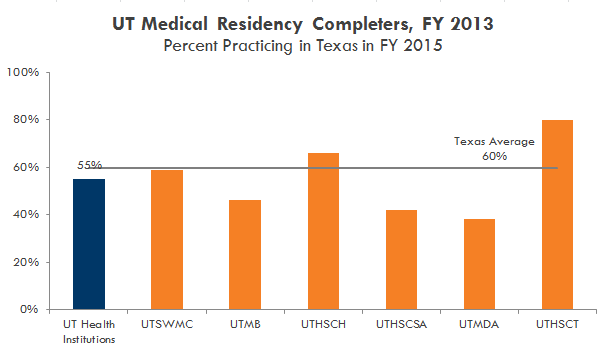
| Institution | % in Texas |
| UTSWMC | 59% |
| UTMB | 46% |
| UTHSCH | 66% |
| UTHSCSA | 42% |
| UTMDA | 38% |
| UTHSCT | 80% |
| UT Health Institutions | 55% |
UT Medical Residency Completers Are Staying in Texas
Approximately 55% of those completing their residency in the UT System in 2013 were found practicing at a Texas address in 2015, two years after completion. This slightly lower than similar analysis on the retention rate for all Texas-trained residents, as reported by The Association of American Medical Colleges for 2014, at 58%, and is higher than the national average of 47%.(1)
The University of Texas System's six medical schools – now including the UT Austin Dell Medical School and the UTRGV School of Medicine – are educating our future doctors to help fulfill the mission to provide excellent, affordable, and compassionate patient care to the state. Further, all six of the UT health institutions train medical residents. In fact, in 2016, UT System will train more than 70% of the medical residents in the state, according to data available from Texas Higher Education Coordinating Board. Still, there is a critical shortage in primary care and specialists in Texas. The state ranks near the bottom (41st) among U.S. states for physicians per capita.(1)
After medical school graduation, new physicians must then complete their graduate medical education (GME, or residency). However, there is a shortage in the number of residency slots available in Texas for graduating medical students, forcing graduates to leave the state.(2) The state has recently decreased funding for residency spots and as a result UT System's number of residency spots dropped to 3,800 in 2016. When Texas institution medical school graduates are also able to complete their residency in Texas, 81% of them remain in the state to practice (compared to the 60% overall).
The state invests $186,000 to train each medical student. In order for the state’s investment to pay off fully, and for Texas to meet the growing demand for physicians, our medical school graduates must be able to remain in Texas for their residency. This greatly increases the chances that they will stay and practice in Texas, and contribute to the healthcare workforce of the state.
About the Data
The percent of Medical Residency Completers Practicing in Texas (LBB: I-4 & HC-1) is defined as physicians who are practicing medicine at a Texas address two years after completing an institutionally-affiliated and accredited residency training program in Texas. For example, for those completing their residency training program in 2013, this metric looks at whether or not they are practicing medicine at a Texas address in 2015 – two years after completion.
Sources
Texas Higher Education Coordinating Board, Accountability System, Patient Care.

